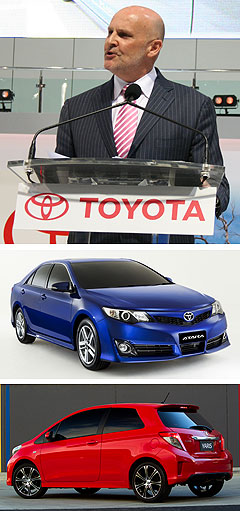Toyota chasing 23% share by year’s end
BY RON HAMMERTON | 9th Sep 2011

Hammered down to only a 13 per cent market share in June as stock dried up in the wake of the disaster that pummeled Toyota more than any other manufacturer, the market leader fought its way back to an 18 per cent share last month with 15,885 vehicle sales – down just 4.5 per cent on the same month last year.
The company’s senior executive director sales and marketing David Buttner told GoAuto at this week’s HiLux facelift launch in Townsville that Toyota was hoping for a sales jump to 19,000 units this month, which would make it Toyota’s best month since December last year.
He said he was aiming for a total of 60,000 sales in the last quarter as normal supply resumed and new models such as the facelifted HiLux, all-new Yaris and the redesigned version of it locally made Camry came on stream.
“We would really like to run through the last quarter at about 60,000 units, to get our share up about 23 per cent, so we have a good foundation to launch in 2012,” he said.
Toyota has previously stated that it wants a 25 per cent share of the market by 2012 – a year when it will have a fresh range of key models at the start of its vehicle launch cycle.

The restoration of Toyota vehicle stocks has allowed the company to unleash a massive ‘Toyotathon Gold Fleet Discounts’ campaign to make up for lost ground, particularly from June when the company usually rolls out a massive end-of-financial-year sales push.
Mr Buttner acknowledged that run-out volumes of Camry would be affected by rolling strikes at Toyota’s Altona plant ahead of the new-model changeover, but he said he hoped that would be limited.
He said that immediately after earthquake, predictions within Toyota were that global Toyota production could be cut by 90 per cent and production shortages would last until late this year.
Mr Buttner said that after selling more than 200,000 vehicles last year, Toyota was facing an adjusted 2011 target of just 130,000 immediately after the earthquake.
“At one stage in mid-April it looking like it would be about 130,000,” he said. “I am hopeful now of about mid-190,000s.
“From where we could have been on the back of the supply constraints on the back of the tsunami, it is a much better position to be in than we ever expected to be.” Year to date, Toyota has sold 113,993 vehicles, down 19.4 per cent on the 141,353 units sold in the first eight months of last year.
Mr Buttner said Toyota had been ready to ramp up production of the new HiLux ute in Thailand to cater for the facelifted model, and much of that extra production had now been pulled forward to help meet outstanding orders.
He said he expected HiLux to achieve between 32,000 and 38,000 units this year – down from about 40,000 last year.
But he expects the facelifted model to carry its momentum into 2012 and achieve 45,000 sales, despite competition from all-new rivals.
Mr Buttner is predicting a million-unit market for 2011, contrary to some others in the industry who fear it will fall short in the current economic climate.
"Unprecedented mining, construction and infrastructure investments are driving the Australian economy," he said.
"Automotive producers such as Toyota are benefiting from strong demand for new vehicles being generated as a result of these huge injections of capital.” Apart from the mass-selling models that have been in short supply for some months, Toyota has been hamstrung by lack of niche-model stock such as the FJ Cruiser.
The company has a healthy waiting list for the cult all-wheel-drive vehicle, which should see every vehicle arriving in the country sold promptly for some months.
The overall market topped a million sales in 2010, 2008 and 2007. The biggest year was 2007 when sales almost reached 1.05 million on the eve of the global financial crisis.
Last year the 12-month tally was 1.03 million – up 10.5 per cent of 2009’s 937,328.
Currently, the running rate appears to be heading to 997,000 units for the full year in 2011. The comeback of Japanese car-makers such as Toyota will help push that rate over the one million mark, but only if the economy holds up – a fear held by the likes of BMW.
While Toyota is sitting on a 17.1 per cent market share to the end of August, second-placed Holden has 12.8 per cent, Ford 9.2 per cent and Mazda 9.0 per cent.